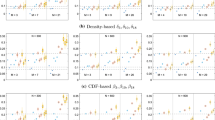Abstract
Sensitivity analysis aims to ascertain how each model input factor influences the variation in the model output. In performing global sensitivity analysis, we often encounter the problem of selecting the required number of runs in order to estimate the first order and/or the total indices accurately at a reasonable computational cost. The Winding Stairs sampling scheme (Jansen M.J.W., Rossing W.A.H., and Daamen R.A. 1994. In: Gasman J. and van Straten G. (Eds.), Predictability and Nonlinear Modelling in Natural Sciences and Economics. pp. 334–343.) is designed to provide an economic way to compute these indices. The main advantage of it is the multiple use of model evaluations, hence reducing the total number of model evaluations by more than half. The scheme is used in three simulation studies to compare its performance with the classic Sobol' LPτ. Results suggest that the Jansen Winding Stairs method provides better estimates of the Total Sensitivity Indices at small sample sizes.
Similar content being viewed by others
References
Abramowitz M. and Stegun I.A. 1970. Handbook of Mathematical Functions. New York, Dover Publications.
Archer G., Saltelli A., and Sobol' I.M. 1997. Sensitivity measures, ANOVA like techniques and the use of bootstrap. Journal of Statistical Computation and Simulation 58: 99–120.
Bratley P. and Fox B.L. 1988. Algorithm 659 implementing Sobol' quasirandom sequence generator. ACM Transactions on Mathematical Sofware 14: 88–100.
Chan K., Saltelli A., Tarantola S., and Sobol' I.M. 2000.Variance based methods. In: Saltelli A., Chan K., and Scott E.M. (Eds.), Mathematical and Statistical Methods for Sensitivity Analysis. London, John Wiley & Sons, Forthcoming.
Homma T. and Saltelli A. 1995. Sensitivity analysis of model output. Performance of the Sobol' quasi-random sequence generator for the integration of the modified Hora and Iman importance measure. Journal Nuclear Science and Technology 32: 1164–1173.
Homma T. and Saltelli A. 1996. Importance measures in global sensitivity analysis of nonlinear models. Reliability Engineering and System Safety 52: 1–17.
Jansen M.J.W. 1996. Winding stairs sample analysis program WINDINGS 2.0. Technical Report, Private communication.
Jansen M.J.W. 1999. Analysis of variance designs for model output. Computer Physics Communications 117: 35–43.
Jansen M.J.W., Rossing W.A.H., and Daamen R.A. 1994. Monte Carlo estimation of uncertainty contributions from several independent multivariate sources. In: Gasman J. and van Straten G. (Eds.), Predictability and Nonlinear Modelling in Natural Sciences and Economics, Kluwer Academic Publishers, pp. 334–343.
McKay M.D. 1997. Non-parametric variance-based methods for assessing uncertainty importance. Reliability Engineering and System Safety 57: 267–279.
McKay M.D., Beckman R.J., and Conover W.J. 1979. A comparison of three methods for selecting values of input variables in the analysis of output from a computer code. Technometrics 21: 239–245.
Morris M.D. 1991. Factorial sampling plans for preliminary computational experiments. Technometrics 33: 161–174.
Saltelli A. and Bolado R. 1998. An alternative way to compute Fourier Amplitude Sensitivity Test (FAST). Computational Statistics and Data Analysis 26: 445–460.
Saltelli A. and Sobol' I.M. 1995. About the use of rank transformation in sensitivity analysis of model output. Reliability Engineering and System Safety 50: 225–239.
Saltelli A., Tarantola S., and Chan K. 1999. A quantitative, model independent method for global sensitivity analysis of model output. Technometrics 41: 39–56.
Šaltenis V. and Dzemyda G. 1982. Structure analysis of extremal problems using an approximation of characteristics. Optimal Decision Theory 8: 124–138.
Sobol' I.M. 1967. On the distribution of points in a cube and the approximate evaluation of integrals. USSR Computational Mathematics and Mathematical Physics 7: 86–112.
Sobol' I.M. 1976. Uniformly distributed sequences with an additional uniform property. USSR Computational Mathematics and Mathematical Physics 16: 236–242.
Sobol' I.M. 1993. Sensitivity analysis for nonlinear mathematical models. Mathematical Modeling & Computational Experiment. 1: 407–414.
Sobol' I.M. 1994. A Primer for the Monte Carlo Method. Boca Raton, CRC Press, USA.
Sobol' I.M., Turchaninov V.I., Levitan Y.L., and Shukhman B.V. 1992. Quasirandom sequence generators. Preprint, Keldysh Institute of Applied Mathematics, Russian Academy of Sciences.
Author information
Authors and Affiliations
Rights and permissions
About this article
Cite this article
Chan, K., Saltelli, A. & Tarantola, S. Winding Stairs: A sampling tool to compute sensitivity indices. Statistics and Computing 10, 187–196 (2000). https://doi.org/10.1023/A:1008950625967
Issue Date:
DOI: https://doi.org/10.1023/A:1008950625967




